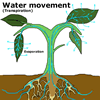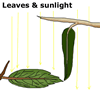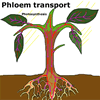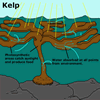Most large land plants belong to the Phylum Tracheophyta which have a system of internal tubes to transport water and nutrients around the plant . These tubes - called vascular bundles - also provide support for the plant, allowing the green leaves maximum exposure to sunlight.
Xylem
 The tubes which form a pipeline for water and minerals from the soil
are called xylem. The water is transported through the tiny root hairs,
up through the roots and stems to the leaves where it is required for
photosynthesis (see Plants
systems B: Photosynthesis, nutrition and respiration). Much of this
water evaporates through small openings (stomata) on the underside of
the leaves. This process, called transpiration, helps draw more water
up the plant against gravity, because of the cohesive force between the
water molecules. As it is the Sun which evaporates the water creating
the "pull", the Sun is therefore the energy source for water
uptake.
The tubes which form a pipeline for water and minerals from the soil
are called xylem. The water is transported through the tiny root hairs,
up through the roots and stems to the leaves where it is required for
photosynthesis (see Plants
systems B: Photosynthesis, nutrition and respiration). Much of this
water evaporates through small openings (stomata) on the underside of
the leaves. This process, called transpiration, helps draw more water
up the plant against gravity, because of the cohesive force between the
water molecules. As it is the Sun which evaporates the water creating
the "pull", the Sun is therefore the energy source for water
uptake.
 A medium-size tree (e.g. beech) can lose about 500 kg of water a
day through transpiration. Desert plants reduce this loss by closing off
the stomata in the heat of the day, having smaller leaves, or having the
stomata embedded in pits, or displaying the leaves vertically to reduce
the amount of sunlight falling directly on them.
A medium-size tree (e.g. beech) can lose about 500 kg of water a
day through transpiration. Desert plants reduce this loss by closing off
the stomata in the heat of the day, having smaller leaves, or having the
stomata embedded in pits, or displaying the leaves vertically to reduce
the amount of sunlight falling directly on them.
 The
xylem vessels become thickened and woody as the plant grows, thus providing
support for the stem so that maximum display of leaves to sunlight is
possible.
The
xylem vessels become thickened and woody as the plant grows, thus providing
support for the stem so that maximum display of leaves to sunlight is
possible.
The bundles of xylem tissue can easily be seen in a cut stick of celery
placed in coloured water.
Phloem
 As all living cells need energy, food made in the leaves by photosynthesis
must be carried to all parts of the plant, both downwards to the roots
and upwards to the growing shoots.
As all living cells need energy, food made in the leaves by photosynthesis
must be carried to all parts of the plant, both downwards to the roots
and upwards to the growing shoots.
Alongside the xylem, in the vascular bundles, is the phloem tissue. The cylindrical-shaped cells of the phloem lie end-to-end forming long tubes transporting sugars and proteins.
"Ringbarking" large trees involves cutting through the bark deep enough to damage the phloem tissue preventing food transport throughout the plant. The tree therefore slowly dies so it can no longer take up water which is then available for use by surrounding crops. The tree does, however, remain intact providing hollows and nesting sites for animals.
 Because water provides buoyancy, large marine kelp do not need vascular
tissue (xylem and phloem) to support the plant or hold the photosynthesising
parts up to the light. Water and minerals can pass directly into all parts
of the plant as it is in direct contact with the surrounding water. Therefore
complex transport and support systems are not necessary.
Because water provides buoyancy, large marine kelp do not need vascular
tissue (xylem and phloem) to support the plant or hold the photosynthesising
parts up to the light. Water and minerals can pass directly into all parts
of the plant as it is in direct contact with the surrounding water. Therefore
complex transport and support systems are not necessary.| Copyright owned by the State of Victoria (Department of Education and Early Childhood Development). Used with Permission. |